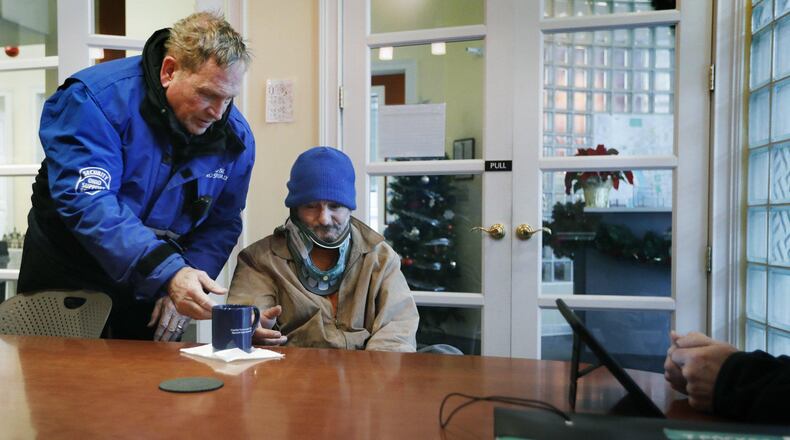Locally, the number of those experiencing homelessness in Montgomery County remained unchanged, said Kathleen Shanahan, housing and homeless solutions program coordinator for Montgomery County.
“Our numbers are virtually flat from 2018 to 2019,” Shanahan said.
There were 478 households experiencing homelessness in Montgomery County in 2018. In 2019, there were 475 households counted that were experiencing homelessness.
County officials found 402 adults in a shelter and 48 living unsheltered on the street.
HUD Secretary Ben Carson traveled to Ohio last week to announce nearly $2.2 billion in grants to support thousands of homeless assistance programs across the nation.
Dayton and Montgomery County agencies were awarded more than $10 million. This funding will support 21 temporary or permanent supportive housing programs in the community, county officials said.
Agencies across Ohio were awarded nearly $107 million, which is about $200 million more than the grants awarded to the state last year.
MORE: HUD awards $9.5M within county to fight homelessness
How does Dayton compare?
Nearly nine out of every 10,000 people in Ohio experienced homelessness in 2019.
The biggest increases in homelessness in the state came from the Columbus area and the 80 non-urban counties in Ohio.
The number of homeless people in the Columbus area increased by 5.5%, according to the HUD report. From 2018 to 2019, the non-urban counties saw an 11% increase of homelessness.
In Toledo, the number of homeless people dropped by almost 8% from 2018 to 2019. Cincinnati’s homelessness rate decreased by nearly 3% from 2018 to 2019.
Nationally, the estimated number of people experiencing long-term, chronic homelessness increased 8.5% between 2018 and 2019. This increase was concentrated on the West Coast, with the largest increases in California.
The number of those experiencing chronic homelessness in Montgomery County has remained relatively flat since 2017, Shanahan said. There were 28 people counted who were experiencing chronic homelessness in 2019 in the county. There were 30 chronically homeless people in 2018 and 2017.
There has been a 66% decrease in the number of chronically homeless people in Montgomery County since 2010. Since 2007, that number has dropped by 77%.
“It is our goal to make sure that homelessness is a rare, non-recurring and brief experience,” Rodriguez said.
Homelessness for veterans
Nationally, homelessness among veterans and families with children continued to fall in 2019. The number of homeless veterans declined by 2.1% and homelessness among families fell 4.8% in 2019.
Homelessness among veterans is half of what was reported in 2010, the HUD report said. The homelessness rate for families with children is down more than 32% since 2010.
Gina Rodriguez, a spokeswoman for HUD, said HUD has focused on reducing homelessness for veterans and families with children since 2011.
“Keeping our resources targeted is important to eliminating the issue,” Rodriguez said.
Montgomery County effectively eliminated veterans’ homelessness in 2016, county officials said. HUD certified the measure.
The declaration does not mean homelessness is non-existent among veterans in Montgomery County, but that the community has an effective way to identify and house homeless veterans rapidly,
MORE: County has ‘effectively’ ended homelessness among veterans
How HUD counts the homeless
HUD’s national estimate of people experiencing homelessness is based on data reported by approximately 3,000 cities and counties across the nation. Every year on a single night in January, planning agencies called “Continuums of Care,” (COC) along with tens of thousands of volunteers, count single people and families living in emergency shelters, transitional housing programs and on the street.
Every year on the fourth Tuesday of January, communities in Ohio count people experiencing homelessness. Rodriguez said it is up to local agencies to decide when to perform the count. In 2019, Montgomery County performed its count on Jan. 22.
The 2020 count will be on Tuesday, Jan. 28, according to Shanahan.
In Montgomery County, the count includes people in emergency shelters like Daybreak, Gettysburg Gateway for Men, Holt Street and the YWCA Domestic Violence shelter. The count also includes people sleeping in unsheltered places, like under bridges, in cars or abandoned buildings.
RELATED: Homeless, jobless: Tornado throws Dayton man’s life into disarray
The number of people living unsheltered is weather dependent, Shanahan said.
“Some Januaries are in the negative temperatures, which forces some people who normally would choose to be outside into shelters,” Shanahan said.
Shanahan said the county sends a survey to those in shelters. This year, a question was added about the Memorial Day tornadoes.
“The tornadoes contributed to homelessness, they certainly impacted the housing landscape of our community,” Shanahan said. “We lost thousands of units of affordable housing. Housing is much scarcer, thanks to the tornadoes.”
About the Author

